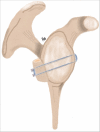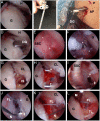Comprehensive management of posterior shoulder instability: diagnosis, indications, and technique for arthroscopic bone block augmentation
- PMID: 35924637
- PMCID: PMC9458942
- DOI: 10.1530/EOR-22-0009
Comprehensive management of posterior shoulder instability: diagnosis, indications, and technique for arthroscopic bone block augmentation
Abstract
Recurrent posterior glenohumeral instability is an entity that demands a high clinical suspicion and a detailed study for a correct approach and treatment. Its classification must consider its biomechanics, whether it is due to functional muscular imbalance or to structural changes, volition, and intentionality. Due to its varied clinical presentations and different structural alterations, ranging from capsule-labral lesions and bone defects to glenoid dysplasia and retroversion, the different treatment alternatives available have historically had a high incidence of failure. A detailed radiographic assessment, with both CT and MRI, with a precise assessment of glenoid and humeral bone defects and of glenoid morphology, is mandatory. Physiotherapy focused on periscapular muscle reeducation and external rotator strengthening is always the first line of treatment. When conservative treatment fails, surgical treatment must be guided by the structural lesions present, ranging from soft tissue repair to posterior bone block techniques to restore or increase the articular surface. Bone block procedures are indicated in cases of recurrent posterior instability after the failure of conservative treatment or soft tissue techniques, as well as symptomatic demonstrable nonintentional instability, presence of a posterior glenoid defect >10%, increased glenoid retroversion between 10 and 25°, and posterior rim dysplasia. Bone block fixation techniques that avoid screws and metal allow for satisfactory initial clinical results in a safe and reproducible way. An algorithm for the approach and treatment of recurrent posterior glenohumeral instability is presented, as well as the author's preferred surgical technique for arthroscopic posterior bone block.
Keywords: bone block; bone defect; instability; posterior; shoulder.
Figures







